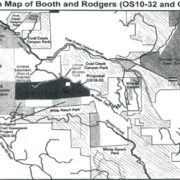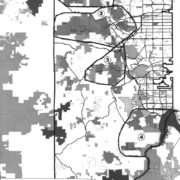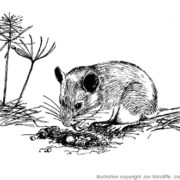Dear Sirs:
PLAN Jeffco submits these comments in response to the Fish and Wildlife Services’ request for public comments as part of its NEPA scoping process relating to the Services’ development of an EA. The EA is being developed to analyze the impacts of the Service’s proposed transfer/sale of a 300-foot wide strip of land along the eastern boundary of the Rocky Flats National Wildlife Refuge for use as a transportation corridor.
PLAN Jeffco is the citizens group that, in 1972, initiated the first county open space acquisition program in the country. We continue to monitor, advise and work with the staff, Open Space Advisory Committee and elected officials regarding the Jefferson County Open Space Program. In 1989, Plan Jeffco joined with other groups to urge the Open Space Program to preserve and acquire the important natural habitat in the Rocky Flats ecosystem including the acquisition of Section 16. That effort has resulted in much open space preservation by Jeffco which protects the habitat as well as the scenic vistas in the area near the Refuge.
We are very concerned about the planned scope of the NEPA analysis which would only look at the impacts of the transfer on the lands within the National Wildlife Refuge System and would ignore the impacts on the impacted communities outside of the Refuge System. To comply with NEPA, FWS cannot wear blinders nor can it avoid addressing the indirect impacts to the people, wildlife, scenic vistas, already congested Hwy 93, water, air quality, and noise resulting from the transfer of the land for use as a transportation corridor. The Jefferson Parkway Public Highway Authority, the JPPHA, has requested the corridor be transferred to it so it can use the land to construct a toll way; whereas the City of Golden has requested the land be transferred to it so it can construct a bike way for use by bikers, pedestrians or equestrians. The impacts of these two proposals on the affected environment outside of the Rocky Flats Refuge are obviously very different in intensity and in scope. These off-refuge impacts must be analyzed in the EA for the Service to comply with NEPA.
The type of detrimental impacts we are particularly concerned about are the future foreseeable effects from the construction and use of the toll way and from the induced accelerated development. These clearly fall within the definition of “indirect impacts” as set forth in CEQ’s NEPA regulations at 40 CFR Part 1508.8. Indirect effects include those “which are caused by the action and are later in time or farther removed in distance, but are still reasonably foreseeable. Indirect effects may include growth inducing effects and other effects related to induced changes in the pattern of land use, population density or growth rate, and related effects on air and water and other natural systems, including ecosystems.”
Additionally, some of these off-refuge impacts also are significant and will require an EIS and not merely an EA. As shown by the following, these impacts fall within the terms included in CEQ’s regulatory definition of “significance” at 40 CFR Part 1508.27.
TRAFFIC IMPACTS
If the Service were to transfer the lands in the transportation corridor to the JPPHA, the foreseeable impacts to those of us who use the roads in the northern part of Jefferson County will be extremely negative and significant. Based on data in the JPPA System Level Study for the Jefferson Parkway (July 20, 2009) submitted to CDOT and DRCOG in July 2009, Golden prepared the map shown in Attachment 1. This map dramatically shows that by 2015, toll way traffic will cause a 38% increase in traffic on Hwy 93, which at certain times is at or above capacity causing stop and go conditions for miles. It also shows a 117% projected traffic increase on 64th Avenue and significant increases in traffic on C-40, parts of 6th Avenue, I-70 and C-470 and on other roads in the area. Attachment 1 shows that there are some anticipated decreases in the amount of traffic projected but they are more than offset by the size of the increases and negative effects on traffic on other roads. Also refer to Attachment 2, for a depiction of the 2035 traffic impacts which continue to predict significant increases in other roads due to the toll way.
These traffic volumes do not include the additional traffic that is projected to be generated by the development of the Candelas Property located south of the Refuge. The toll way is specifically designed benefit this planned development by transecting it so it could funnel traffic to and from this 1451 acre new urban center. The designs for the Property include high density office, commercial and residential development which will be accelerated by construction of the toll way. According to the System Study, by 2015 18,000-24,000 trips a day will be generated by Candelas development, greatly increasing the traffic load and commuter time on the roads shown on Attachments 1 and 2. Candelas generated traffic is projected to worsen by 2035 when 23,000-39,000 trips a day will enter and leave the development. These projected traffic increases will only worsen the traffic conditions on the roads in the northern part of Jefferson County.
These increased traffic volumes will not only lengthen the time spent by commuters sitting in traffic and on traffic flow, it will have air quality and noise impacts on those who live near and use the impacted roads. Based on the above described projections by JPPHA, the intensity and the severity of the impacts are significant. Similarly, the NEPA analysis should look at the indirect traffic impacts that would result from Golden’s bike way proposal.
POTENTIAL PLUTONIUM CONTAMINATION
PLAN Jeffco recognizes that before the Service accepted transfer of the lands comprising the Rocky Flats Refuge, EPA had certified that the clean-up was complete and that the lands were safe for refuge use. As you know, there are people and entities that dispute these findings. They contend this certification is not valid and that the construction and use of the transportation corridor for a toll way will create a significant human health risk.
There are several scientific studies that support these serious public health concerns. The latest information was sampled in April 2010 and analyzed by Marco Kaltofen, Boston Chemical Data Corp., Natick, MA. It showed plutonium contamination from dust blown from the Refuge onto land across from the Refuge on Indiana St. Additionally, the soil sampling conducted by the Citizens’ Environmental Sampling Committee conducted in 1993 and 1994 also found plutonium contamination that had originated on Rocky Flats in areas as far as 5-6 miles from the Rocky Flats plant. Finally, there is the 1975 study by the Jefferson County Health Department’s Director, CJ Johnson, that also showed potential health hazards due to plutonium in the dust that may be inhaled by humans.
Even after the EPA certification there continues to be a serious controversy over the health risks from digging up the transportation corridor for construction and use as a toll way; this constitutes a “significant” indirect impact of any alternative in which the Service transfers the transportation corridor to the JPPHA which intends to use the corridor to build a toll way. Based on this significant scientific controversy over human health effects, FWS should conclude that the land transfer to JPPHA is likely to have a significant impact on the human environment. Therefore, NEPA requires that this issue be analyzed in an EIS.
Furthermore, we have found no evidence that, prior to certification, EPA analyzed and evaluated the sufficiency of the Rocky Flats clean-up in relation to the future use of the transportation corridor for construction and use as highway. To the contrary, the EPA clean-up standard was based on the risks to a refuge worker working 4 hours indoors and 4 hours outside on the refuge for 18 years, not on a person grading the land during highway construction. Nor was the land cleaned up to a standard that would not risk the health of those living and using roads in the area, of refuge staff or visitors or of all of us in the Denver metro area that may breathe in the construction dust during and after the toll way is built.
The lack of EPA certification for construction and use of the corridor for highway, means that there may continue to be significant health risks resulting from using the transportation corridor for other than for refuge purposes. Because there is no empirical data for the Service to rely on to determine that the indirect impacts from disturbance of the surface and subsurface due to highway construction will not cause health risks, the Service must obtain such information prior to any FONSI or completion of an EIS and ROD. Although the indirect human health impacts from the construction and use of the corridor for a bike way should be much less than those from road construction, similar impact information should be obtained regarding potential bike way construction and use.
ECOSYSTEM DEGRADATION
As mentioned above, PLAN Jeffco was the catalyst for the Jefferson County Open Space Program. This program, along with the City of Boulder, Boulder County, the City of Westminster, and the City of Arvada have preserved wildlife corridors extending from the Foothills to the plains East of the proposed toll way. Migration along these corridors is significant and the toll way will provide a significant barrier to this migration.
In addition the dissecting of these corridors, the toll way and the development it will accelerated will diminish the other purposes for which these lands were preserved, i.e. open vistas, protecting the mountain backdrop, and providing natural areas for public enjoyment.
The Service must analyze the direct and indirect impacts of all the alternatives on the open space values, including scenery, wildlife, and recreation.
AIR QUALITY
The Service is required to take a hard look at the impacts associated with all alternatives under consideration. Relative to air quality, the Service must assess the effect the toll way and bike way would have on ozone levels in the region, and assess whether the toll way would contribute to the region falling out of compliance with the new and stricter ozone standards expected to be adopted by the Environmental Protection Agency in the next few months.
In 2008, the Environmental Protection Agency revised the ozone National Ambient Air Quality Standards (“NAAQS”) to 0.075 parts per million (“ppm”). See 40 C.F.R. § 50.15. However, the EPA has proposed to strengthen the ozone NAAQS by setting a limit of no more than 0.060-0.070 parts per million over an 8-hour period. See 75 Fed. Reg. 2938-3052 (Jan. 19, 2010). The EPA expects to finalize the new ozone NAAQS between 0.060 and 0.070 parts per million in July of 2011. See U.S. EPA, Declaration of Regina McCarthy (Dec. 8, 2010), available at http://www.epa.gov/glo/pdfs/20101208declaration.pdf (last visited July 28, 2011).
Even though the Denver Regional Council of Governments (DRCOG) looked at ozone levels when they adopted the regional transportation plan (RTP), DRCOG did not assess the effects on ozone levels of the RTP relative to newer and stricter ozone standards adopted by the EPA in 2008 and likely to be adopted in 2011. Hence, the Service cannot rely on the DRCOG analysis and must conduct its own, and disclose the results, including the likelihood of non-attainment with the ozone standards, in the environmental analysis. Moreover, because the potential consequences of failing to meet the new ozone standard under the Clean Air Act are severe and significant, and because the public health impacts of increased ozone are so serious, the Service must undertake an EIS instead of an EA to comply with the NEPA regulations.
Lastly, the Service is required to analyze the impacts of the alternatives on other air pollutants for which the EPA has established NAAQS, including, but not limited to, the 1-hour nitrogen dioxide NAAQS (see 75 Fed. Reg. 6474-6537 (Feb. 9, 2010)), the particulate matter less than 10 microns in diameter NAAQS (see 40 C.F.R. §§ 50.10 and 52.21(c)), and particulate matter less than 2.5 microns in diameter NAAQS (see 40 C.F.R. § 50.13 and 75 Fed. Reg. 64864-64907 (Oct. 20, 2010)).
DRCOG is not required to analyze impacts to such NAAQS because the region is not designated nonattainment. However, simply because the area is not designated nonattainment at the present does not mean that future development related to the proposed actions will not jeopardize compliance with other NAAQS. Thus, the Fish and Wildlife Service should analyze all reasonably foreseeable air quality impacts, including impacts to the ozone, particulate matter, and nitrogen dioxide NAAQS resulting from the proposed transfer/sale of the corridor.
Thank you for this opportunity to comment. We urge the Service to undertake an EIS. If the Service declines at this point in the process to switch to an EIS, we ask that the Service ensure that there is an adequate period for public comment on the draft EA.
Sincerely yours,
Margot Zallen, Chair, PLANJeffco






